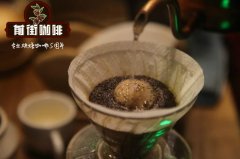What is the processing method of lactic acid fermented coffee? Is lactic acid fermentation the same as carbon dioxide treatment?

Professional coffee knowledge exchange more coffee bean information please follow the coffee workshop (Wechat official account cafe_style)
The three giants of early treatment are sun exposure, water washing and honey treatment, while the process of post-processing has a very important impact on the flavor of coffee.
From picking the fruit to removing the pericarp and pectin, the pectin layer is the most difficult to deal with, because it is strongly attached to the coffee bean. When the pectin is dried and removed, the coffee bean will produce fermentation, which has a great impact on the final flavor of the coffee bean. The lack of fermentation flavor is common, excessive fermentation will stink acid, the early three major treatments are exposed to the environment, coffee is greatly affected by the environment, and there are many uncontrollable factors. So there is no way to stabilize the quality of coffee. (like fruit, the quality of each season is different.)
What is meant by 'anaerobic fermentation / lactic acid fermentation treatment' = carbon dioxide treatment
100% ripe fruit is manually harvested to the treatment plant to carry out 'anaerobic fermentation'. The average fermentation time of the whole fruit is 24-48 hours and then sent to the greenhouse for 4 days to remove the pectin layer, and then placed in the African scaffolding bed for 18-20 days. carry on the final drying operation, and finally put the coffee in a bucket and seal it.
The four main elements of this approach are:
1. Shade system
The shade system can effectively block out the sun, so that the pulp can produce more sugar, thus making the final coffee more sweet and wonderful and shiny sour.
2. Stainless steel container
Coffee beans are fermented in stainless steel containers as soon as they are picked, instead of using traditional cement or ceramic tile containers, which absorb the flavor of coffee beans rather than retain more of the flavor in the pulp of coffee. The flavor of coffee can be made cleaner by using stainless steel containers.
3. Carbon dioxide
The container in which the coffee beans are placed is then sealed and pressurized with carbon dioxide so that there is no oxygen in the container. This ensures that the flavor and aroma of all the coffee are retained in the coffee, and the flavor of the coffee is more obvious.
4. Controllable temperature
Finally, these containers of coffee beans are placed in a controlled environment to control more of the factors that replicate the same flavor of coffee beans. However, the traditional treatment methods are affected by weather, humidity and other factors, so it is difficult to ensure that the flavor of beans treated each time is consistent.
Anaerobic fermentation treatment (Anaerobic/Carbonic Maceration) is mostly translated into carbon dioxide impregnation, anaerobic fermentation or red wine treatment, and the literal translation of production areas is also translated as pressure honey treatment. Like brewing wine, the removed coffee pulp and pectin coffee beans are fermented in a bucket, and the pressure in the bucket slows down the fermentation rate, so the taste of those cinnamon biscuits is also the product of anaerobic fermentation.
Sasa mentioned that we know little about fermentation, but it is very important.
He said at the meeting: "I flew to countries around the world to taste coffee and tested the coffee processing process with more than 50 farmers. I also experimented on my own farm and found that there were too many unstable factors in the traditional treatment methods in the past. The most unstable of which is the effect of fermentation.
He mentioned that in fact, there are some examples of how fermentation can improve or reduce the quality of coffee or even reach an eight-point difference.
When most boutique coffee scores are defined at 80-92 out of 100, eight is a startling difference.
END
Important Notice :
前街咖啡 FrontStreet Coffee has moved to new addredd:
FrontStreet Coffee Address: 315,Donghua East Road,GuangZhou
Tel:020 38364473
- Prev

What is Japanese ice hand punch? How do you do Japanese ice hand flushing at home? Body materials need to be prepared.
Professional coffee knowledge exchange more coffee bean information please follow the coffee workshop (Wechat official account cafe_style) what is Japanese iced coffee? The method of making Japanese iced coffee is very simple, first put ice cubes in the coffee cup, and then use the common method to brew the coffee in hot water. ? Soaked coffee such as cold extract usually takes 6-12 hours to make, while Japanese iced coffee is made from
- Next

What is very shallow baking? Does very shallow roasted coffee have to be sour? How to bake coffee in very shallow water
Professional coffee knowledge exchange more coffee bean information Please pay attention to the coffee workshop (Wechat official account cafe_style) the well-known roasting degree of coffee is the American term light roasting, medium roasting, deep (heavy) roasting, which can be subdivided into 8 stages, and the difference of roasting degree varies with different regions. The roasting degree and flavor are briefly introduced as follows: (1) Light Roast:
Related
- What is the meaning of lactic acid fermentation with coffee bean treatment?
- How to judge the state of foam by sound?
- How does the latte pull out the unicorn pattern? Come to get for a little trick to improve the flower pull!
- Will flower pulling affect the taste of the latte?
- Do you know the history of coffee?
- The difference between honey treatment and sun washing what is raisin honey treatment?
- What kind of milk can a novice use to make coffee foam to keep the foam longer? The correct method and skills of milking tutorial sharing
- Why do washed coffee beans taste sour? Flavor characteristics of washed Coffee
- Introduction to the skill of how to practice the size and height of water injection around the circle of hand-brewed coffee
- How do beginners practice coffee flower drawing from scratch?

